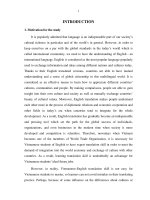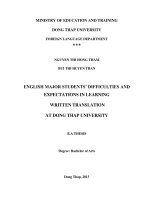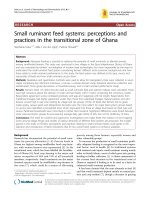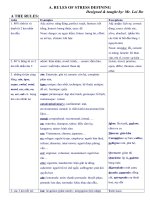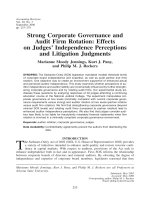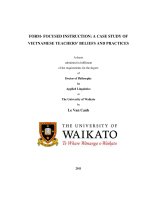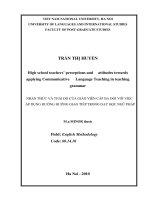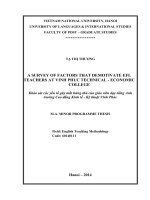EFL teachers’ perceptions and practices regarding learner autonomy at Dong Thap University, Vietnam
Bạn đang xem bản rút gọn của tài liệu. Xem và tải ngay bản đầy đủ của tài liệu tại đây (268.68 KB, 13 trang )
Hue University Journal of Social Science and Humanities
ISSN 2588-1213
Vol. 127, No. 6B, 2018, Tr. 05-17; />
EFL TEACHERS’ PERCEPTIONS AND PRACTICES
REGARDING LEARNER AUTONOMY AT DONG THAP
UNIVERSITY, VIETNAM
Le Thanh Nguyet Anh*
College of Foreign Languages, Hue University
57 Nguyen Khoa Chiem, Hue City, Vietnam
Abstract. Learner autonomy is currently one of the central themes in language education. Autonomous
learning plays an important role not only in university life but also throughout the life of learners. Exploring teachers’ perceptions and practices regarding learner autonomy (LA) is necessary, especially in the
local contexts, to provide more insights intothe field. The present study was conducted with 20 English-asa-foreign-language (EFL) teachers at Dong Thap University, Vietnam through interviews. The findings
showed that the teachers had positive understandingsof the related aspects and levels of learner autonomy. In practice, they made significant attempts to cultivate students’ autonomy. However, they faced certain common problems as shared by EFL teachers at other universities in Vietnam. On the basis of the
findings a number of implications have been made.
Keywords. learner autonomy, teacher, student, EFL, perception, practice.
1. Introduction
In the context of the informative technological development these days and the changing situation of English language teaching in the 21st century, autonomy is considered as a crucial goal in
the teaching and learning process. Therefore, the Ministry of Education and Training (MOET)of
Vietnam has practiced the Law of Higher Education to promote the quality of the higher educative system approaching international standards in the 21stcentury. Up to 2017, MOET had tried
to integrate and develop learner autonomy in the credit education system. A number of new
policies regarding this matter have been issued. Article 40 of the Education Law of Vietnam
(National Assembly of Vietnam, 2005) states the criteriaaboutthe contents and methods of education in higher education where LA is animportant element: “Training methods in higher education must be brought into play to foster the learners’ ability to be active learners, to study and
to do research by themselves, and to foster their practical abilities, self-motivation, creative
thinking, and ambition”(p.13).Hence, the teaching and learning method in higher education
needs to be fulfilled with three major aims: (1) fostering students to learn, autonomously and
* Corresponding:
Submitted: 27-09-2017; Revised: 26-03-2018; Acceptted: 06-04-2018.
Le Thanh Nguyet Anh
Vol. 127, No. 6B, 2018
activelyself-researching, (2) increasing their creative thinking andpractical abilities, and (3) cultivating their self-motivation and ambition to achieve life-plans. Additionally, in the developmental education policy in the 2011 – 2020 period, accompanying the Decision number 711/QDTTg, 13 June 2012 issued by the Prime Minister (Prime Minister of Vietnam, 2012), the Government emphasized the need to innovate teaching methods and assessment, training students
with the aim of developing their activeness, creativity, and learning autonomous ability.
However, for limited reasons, traditional teaching and learning English, or the teachercentered method in the Mekong Delta is still found common, especially in local colleges/universities where most freshmen are at a low academic level, even though educational reforms of the English subject in Vietnam have been carried out for over almost ten years. In the
rapid technological information era these days, students can find knowledge by a click on the
Internet. Hence, the teacher role should be changed so as to help students to foster their LA
ability effectively. Like other countries on the globe, Vietnam has adopted a credit systemfor
recent years. In this educational system, students are asked to rely more on themselves in learning rather than on their lecturers in classes. The question that appears here is how students are
able to learn autonomously because they did not have the opportunity to develop this method
during high school or have not beeninstructed to do it. Although a number of researchers have
studied EFL teachers’ perceptions and practices towards learner autonomy in Western nations,
Asian countries, including Vietnam (Borg, 2006; Borg & Al-Busaidi, 2012; Keuk &Heng, 2016;
Haji-Othman & Wood, 2016; Tapinta, 2016; Alhaysony, 2016; Nguyen, 2016; Dogan &Mirici,
2017) in recent years, their results have not been comprehensively generalised. Further research
needs to be conductedregardingthis field in such rural areas as the Mekong Delta, South Vietnam, especially in Dong Thap University, where little research about LA among EFL teachers
has been done and where most English majors have a low level of English proficiency (in comparison to that of their partners in other universities in the country).
2. Literature review
What is learner autonomy?
For over three decades, many definitions of LA in language education have been set.
Holec (1981:3) defines it as the “ability to take charge of one’s own learning”. Wenden (1991:15)
states that autonomous learners are the ones who “have acquired the learning strategies, the
knowledge about learning, and the attitudes that enable them to use these skills and knowledge
confidently, flexibly, appropriately and independently of a teacher”. In the same vein,
Littlewood (1999) believes thatLA should consist of the two characteristics: (1) Learners should
have a duty to their learning process; (2) Learners have to design their learning objectives, find
their learning styles and assess their learning process; and adds that autonomy is a popular
kind of learning and can apply in any culture. Meanwhile, Nguyen (2014:21) claims that “learn6
Jos.hueuni.edu.vn
Vol. 123, No. 09, 2016
er autonomy is defined as learner’s willingness, and ability to take responsibility, plan, implement, monitor and evaluate his/her learning with tasks that are constructed in negotiation with
and support from the teacher”. Then, Alhaysony (2016:46) makes a list of different definitions of
LA defined by many language researchers and concludes that most of them focus on
learners’ability, capacity, responsibility, control, demonstration, attitude, willingness, and mode
of learning.
Hence, present definitions of LA are not unanimously shared by researchers around the
world, probably because LA is a multi-dimensional construct. It, yet, unanimously consists of
(1) the learner’s perception, awareness of his/her learning responsibility at the base line level;
and at the higher level (2) ability, strategies, willingness to make plans and perform actions of
learning with and without the instructor assistance.
Previous studies on teachers’ LA perceptions and practices
Leaner autonomy is a complex construct, and teachers’ perception, i.e., what teachers believe (Borg, 2006); is, by all means, crucialin teaching practice. Also, it straightly influences their
designing and conducting classroom activities. Thus, a large number of studies have been done
to exclusively investigate what EFL teachers perceive and how they approach to develop LA in
their specific contexts. The following is some of them.
Borg and Al-Busaidi (2012) carry out a study by using questionnaires and interviews in
Oman in which 61 EFL teachers responded to questionnaires and 20 participated in the interview. The findings showed that teachers had positive perceptions towards the notion of LA and
its advantages for language students; however, these researchers found that teachers’ thought
of enhancing students’ role to decide their learning (i.e. objectives, assessment and materials)
had a distance with their practices. Besides, Dogan and Mirici (2017) conduct a study with 96
EFL instructors in nine Turkish universities to explore those teachers’ perceptions and practices
regarding LA by means of questionnaires and interviews. The results reflected the teachers’
positive opinions on diverse aspects of LA.
Additionally, several LA studieshave been conducted in Asia. Nguyen (2014), for example,
explores LA at ten universities in Hanoi with 188 teachers answering questionnaire and 4 teachers taking part in interview and observed lessons. The results indicated that overall teachers did
not have full understandings of the concept and did not enhance LA due to many factors such
as difficult conditions of their teaching settings, the courses. Specially, they did not know how
to foster LA in classes. In the same line, Wang and Wang (2016) reported their study of 44 language teachers regarding enhancing LA in a Chinese university through questionnaire, interview, and held four workshops to explore EFL teachers’ LA cognition and practices. Their research showed that the participants lacked a clear understanding of aspects of society and culture affecting LA and did not make students increase their perceptions of LA or instruct them to
7
Le Thanh Nguyet Anh
Vol. 127, No. 6B, 2018
evaluate their learning. The researchers, finally, suggest that language teachers’ perceptions
regarding LA should be fostered.
Similarly, Keuk and Heng (2016) carried out their research on70 Cambodian EFLteachers’
beliefs and practices through surveys, interviews, and workshops. Based on the findings, they
highlight the need for developing LA in higher education in their country. Also, Haji-Othman
and Wood (2016) claim the necessity to investigate EFL teachers’ beliefs in LA in the specific
Brunei context. Questionnaires and workshops were used as two tools for them to explore this
field. In addition, Tapinta (2016) conducts a study on Thai EFL teachers’perceptions of
development of LA in the Thai university context. Her study revealed that the participants had
a strong belief in developing LA. The teachers also recognized their role as facilitators in
students’ learning process. Likewise, in the Philippine university context, when exploring and
finding EFL teachers’ perceptions and practices on LA, Ranosa-Madrunio et al. (2016) state that
their teachers understood the role of LA in learners’ learning process. Like other countries in
Asia, they have some barriers in education and culture when applying LA in their teaching
process, namely “prescribed curricula and instructional materials, departmental culture and
policies, exam-based teaching and learning, class size, and lack of training regarding learner
autonomy” (p.127). Furthermore, Nguyen (2016) investigates 84 English language teachers’
beliefs and practices in six universities in Vietnam. He also finds the same problems as previous
researchers in LA. He indicates that teachers do not create chances for students to make choices
and decisions in their own learning.
In spite of a variety of studies investigating EFL teachers’ LA perceptions and practices, the
obtained results are by no means invariant across the board at all aspects under investigation.
Although they are mostly positive, EFL teachers from different contexts understand LA and get
involved in developing it for EFL students at dissimilar levels. The present study revisits LA by
exploringhow EFL teachers from Dong Thap University, a rural area in South Vietnam, think of
LA values and what they are trying to do for its development at the current context. The
researcher hopes to provide more evidence for the current field literature and open to practical
instructions and further studies, at least at this university.
3. Methods
Research questions
1. What do teachers perceive LA and its demonstrations by EFL students?
2. What have teachers done to develop LA?
3. What are the possible constraints they are facing?
4. How do teachers report the effects of LA activities on their students?
Participants
8
Jos.hueuni.edu.vn
Vol. 123, No. 09, 2016
A total of 20 Vietnamese-speaking EFL teachers in the Foreign Language Education Faculty,
(Dong Thap University in the Mekong Delta), voluntarily took part in the interview. There are
six more EFL teachers in the Faculty, but for some personal reasons they refused to join the interview. They were all MA holders, 13 females and seven males, aged from 23 to 50 years, currently teaching English major classes. Like their partners in other universities throughout Vietnam, most of them have so far taught several different subject courses (i.e. speaking, listening,
reading, writing, grammar). It should be noted that by the time the current study was conducted, none of them had attended any workshops or training programs exclusively on EFL
students’ LA.
Data collection instrument
As a research instrument in a qualitative research, narrative interviews are considered as
“unstructured tools, in-depth with specific features, which emerge from the life stories of both
the respondent and cross-examined situational context” (Muylaert et al., 2014, p.185). The reason for the narrative interview to be used is to help the researcher explore EFL teachers’ perceptions and practices about LA more effectively. Since the number of teachers (only 20) was too
small to give reliable results, questionnaires were not suitable for this study. Interviewing questions were divided into three parts: (1) teachers’ perceptions on definitions of LA and the role of
LA in learning language at higher education, (2) teachers’ reflection on their teaching practices
regarding LA, (3) teachers’ assessment of students’ LA ability and teachers’ LA-oriented activities (see Appendix). It aimed to have EFL teachers tell what they thought about LA and what
they conducted LA activities inside and outside the classroom. The information collected from
the teachers’ stories helped to answer the fourresearch questions above.
Procedure
All 20 teachers took part in the face-to-face interview, individually, for about thirty minutes
for each. For convenience and absolute understanding, the interview was administered in
Vietnamese, and was all recorded by the researcher. Every participant was coded. For instance,
teachers No.1, No.2 were coded as T1, T2. Every teacher’s recording was saved in a separate
file. After the transcription finished, it was sent back to the participants, in both Vietnamese and
English version for confirmation and checking.
4. Findings and discussion
What do teachers perceive LA andits demonstrations by EFL students?
Each of the 20 EFL teachers interviewedexpressed their own standpoints, and most of them
addressedtheir strong voices, clear perceptions of LA baseline and higher levels and positive
attitudes towards the role of LA for EFL students.
9
Le Thanh Nguyet Anh
Vol. 127, No. 6B, 2018
T1 and T9 thought that LA is the students’ “ability”. T1 mentioned that EFL students had to
“adjust their learning actively”, and master “the ways to learn autonomously, and selfresearch”. Next, T2, T3, T4, T10, and T17 emphasized the EFL students’ “responsibility” for
learning through setting up their clear learning goals, actively arranging their time, choosing a
place such as the library to learn autonomously, buying books, asking their teachers about what
they wonder, knowing the requirements of the English major as well as their learning program
in four years. T5, T12, and T13 thought that EFL students having LA ability were those who: (1)
actively search materials from websites, forums, their friends, and their teachers to support the
knowledge that the teacher explained in class, (2) need to network or cooperate outside class to
revise the knowledge they learned in classes and find new things. Furthermore, T17 mentioned
two kinds of LA namely “proactive autonomy” and “reactive autonomy”, and said, “The first type
comprises the students who absolutely learn autonomously. The second consists of the students who learn
autonomously with teachers’ instructions. In other words, based on teachers’ plans, activities, and instructions, they are gradually aware of their LA ability. On this basis, they can design their learning
goals and their own learning plan by themselves which are suitable for them”.
Also, T6, T15, T18, T19, and T20 focused on the EFL students’ LA as “attitude”, “selfconsciousness”, and “ability” outside the classroom. According to T6, students had to prepare
new lessons at home before going to class so that when they were in classes, teachers asked
them questions and they could discuss the lessons in groups. Besides, when teachers gave their
learning duty at home such as reading textbooks, studying materials, and doing homework,
they had to complete them all. Next, T7 thought EFL students with LA ability had their own far
vision of their learning as their “capacity”. In addition, T8 indicated that “EFL students with
good LA ability do not need to go to classes as one period in class is fifty minutes and students
practice English very little. Instead, they can actively listen to more English at home, practice
speaking to their friends, and writing as well”.
All the participants appreciated the extreme importance of the EFL students’ LA ability in
learning a foreign language in the integrated time and technology era these days and in their
job in the future. More specifically, T1 and T3 added that “after class, the students need to selfresearch and self-discover knowledge to seek new things from what they have learnt in class”.
Next, T2 and T16 talked about the limited time in class in the credit-education system and emphasized that if EFL students wanted to master the language skills, they had to allocate their
time to practice inside or outside the classroom to use English fluently. Additionally, T4, T11,
T13, and T14 expressed one more function of LA: “It also helps EFL students with lifelong learning
spirit”, and learning is the people’s long-life activity. According to T5, T6, T7, T9, T12, T15, T17,
T18, T19, and T20, the students’ LA practices brought them different experience that would
mainly affect their jobs in the future because, first, they would know how to interact with their
co-workers and others in society; second, LA fostered the problem-solving skills to deal with
10
Jos.hueuni.edu.vn
Vol. 123, No. 09, 2016
the difficult situations they would meet in society in the future; third, LA might train them to
have the leadership ability in small companies or the ability to work in groups or in pairs.
Next, from different perspectives, T8 considered that LA played an important role for EFL
students at Dong Thap University because their background of English was lower than their
partners’ in other universities in Vietnam in general and in Mekong Delta in particular. Thus, he
claimed that they needed to develop LA to keep up with their partners. Also, T10 said that EFL
students had to learn more autonomously to make progress and their necessary skills such as
critical thinking, and communication should be built. T16 thought that the EFL students’ LA
would determine sixty percent of their success.
What have teachers done to develop LA and what are the constraints they are facing?
When asked to talk about the ways to instruct their students to practice LA activities, most
teachers expressed that they used virtually the same methods (T1, T2, T5, T6, T7, T8, T9, T11,
T12, T14, T15, T17, T18, T19, and T20). For example, at the beginning of a course, they designed
their detailed teaching plans with LA accounting for 20% of the course marks. In addition, they
gave homework, exercises or assignments, or questions to students to do at home. Then, in class
they checked whether the students did their duties. Besides, some of the teachers had their own
special ways to hold and instruct their students to carry out LA, and they are as follow.
T3, in the Writing courses, held a portfolio-likeactivity. The students would submit their
paper on time and have another assessment of that paper at the end of the semester. They could
self-correct their papers and submit the best final ones at the end of the semester to her. Furthermore, she asked the students to write their dairy on their notebooks with topics given by
her or chosen by themselves and submitted their notebooks to her every week. In another class,
she had them write journal entries about what they acquired as well as what they did not understand in that writing class in order to help her have a plan to support them. In the first semester of the school year 2016 – 2017, she instructed her students to do peer-correction in writing
on Edmodo – an educational technology website where teachers can share contents, distribute
quizzes, assignments, and manage communication with students, colleagues, and parentsboth
inside and outside the classroom. Students self- or peer-corrected their papers and submitted
their best versions to her at the end of the semester.
T4 always asked his students to learn autonomously in his instructional courses. He believed that LA was like the people’s instinct for survival, and what they knew originated from
LA. In the first period of every course, he gave them clear rules, shared his experience and contents, and told them the class requirements as well aspossible problems they would meet during that course and what they had to do to get good results. In addition, he instructed them,
step by step, to get familiar with the learning methods in a few next periods, and after that they
had to learn autonomously by themselves. For example, in a Translation course, before each
class, he gave the students an assignment, and they used the reading skills to read the text and
11
Le Thanh Nguyet Anh
Vol. 127, No. 6B, 2018
underlined difficult words or phrases which they did not know and looked them up in dictionaries. When they learned new words, they had to explain the words by their own definitions
or explanations, and thus they had to use monolingual dictionaries (English-English dictionaries rather than English-Vietnamese ones). After that, they translated those assignments and
posted them on their folder in the Google drive. They could see their friends’ work. He also
asked them not to copy their friends’ answers and if they did, he would give them a zero mark.
Besides, he divided the class into four groups and gave them a list of topics. Each group discussed to choose some of the topics to translate into Vietnamese at home and then divided work
for each member. They edited their work so that other students could understand. They evaluated their group members’ work. In class, four groups would evaluate each other; for example, group No.2 and group No.3 evaluated group No.1, and to do so, they had to see other
groups’ work on the Google drive. For example, they evaluated the organization of that translation version and the ways of using words effectively, compared with the English version, and
then gave marks. After that, the evaluated group could address to two observing groups about
what they agreed or disagreed with. This made a debate in the class and they could learn autonomously from each other. Even the evaluated group could say they agreed or disagreed with
the marks they received and explained the reasons honestly; for instance, a group gave the evaluated group 7.5 points and the other gave them 8 points. However, the evaluated group was
willing to accept 7.5 points and pointed out some explanations. The teacher thought that way
helped the students increase their LA ability, activeness, honesty, and responsibility for learning.
Meanwhile, for Speaking classes, T13 held English clubs for EFL students to practice together. Also, she told them when they had a chance to meet a foreigner, they should talk to him
or her so as to practice listening and speaking. Concerning Writing classes, as all students had
their account on Facebook these days, she organized some groups on Facebook for them to post
and peer-review their papers. In addition, she held another group for those who liked to compose or create new things. If they wanted, they could write and post their products on their
group’s Facebook page, and the others would read and comment. For British Literature classes,
she gave some links with stories or poems and 3 – 5 questions for them to read and answer at
home to check their understanding, and then they wrote a short report to share their ideas after
they read in classes. As for Listening, she also introduced some websites of short English news
such as BBC, VOA, and links of movies to them. Additionally, she sent a long list of English
songs to them to fill in the blanks and sing to practice both listening and speaking because she
thought that singing isa high level of speaking.
T16 usually held a large number of LA activities for EFL students. In Reading classes, the
activities were designed to be based on the students’ levels. For example, the simplest activity
was a reading passage to read at home, and a short quiz in class to check which students read it
12
Jos.hueuni.edu.vn
Vol. 123, No. 09, 2016
and which ones did not. At the next level, she gave them one to three passages and they designed the questions at home. At level three, the students chose their favorite passages and
wrote questions. She mingled the reading passages among groups and the students worked
again on them in class. When they finished, the authors checked their friends’ answers. At level
four, each student chose their favorite passage, and wrote a five-minute report, and then presented it in class. Atthe most difficult level, they did the reading tests in TOEFL books or ones
of the Vietnamese Standardized Test of English Proficiency tests. They did one reading test in
class and one at home every week. She gave marks for all their activities.
How do teachers report the effects of the LA activities on their students?
Assessing the EFLstudents’ LA capacity, T2 found that generally, the EFL students’ LA ability was very good because they invested their time to learn autonomously. Additionally, T1, T5,
T17, and T20 thought that their students’ LA ability was good. Next, T4, T6, T8, T9, T12, and
T19 claimed that their EFL students’ LA ability was average. T4 explained that students carried
out LA activities following teacher’s requirements, while true LA was more than that. According to T8, his students’ LA ability was average because their beginning background in English
was low. T16 said that from 60% to 70% of students had low LA ability. And for T3, only a few
EFL students owned their true LA ability. Meanwhile, T14 did not know which LA level EFL
students gained. She just said they were still controlled by teachers. Also, T11 said that it was
hard to assess his students’ LA exactly as their consciousness of LA was not good.
When asked to assesstheir LA-oriented activities, all 20 teachers shared their interesting
ideas. T4 said his LA activities were very good. However, he said that he did not have enough
time to check the students’ LA carefully. In addition, T13 thought her LA activities were good
or very good and effective because sometimes after she finished a lesson in class, the students
reminded her of website links for further learning. This indicated that the students concerned
their LA. However, she was not sure about whether they read them at home. Furthermore, T16
held that her LA activities were effective because she worked hard on them. Additionally, T1,
T3, T5, T6, T9, T11, T17, T18, T19, and T20 considered their LA instructions good. However, T2
said that although he found many ways to help the students practice LA and reminded them to
learn autonomously, the results were not so satified as was expected.
T8’s and T15’s teaching practices towards LA activities were self-assessed just over average
because it was hard to observe all students’ LA in three or four classes. Also, T15 thought she
did not spend much time on them. Similarly, T12 felt that her instructions and holding students’
LA activities were not appropriate. Meanwhile, T10 said that she always took responsibility for
teaching. Also, in whatever class she taught, right at the first meeting and throughout the
course, she always told, reminded, and instructed students about LA. She found that it was
hard for her to self-assess because she tried her best to do what she thought was good for them.
For those who learned autonomously she thought they were good and the rest were not.
13
Le Thanh Nguyet Anh
Vol. 127, No. 6B, 2018
The findings above confirmed that the interviewed teachers had clear conceptualisations of
LA as capability, responsibility, self-consciousness, and activeness in language learning. More specifically, the teachers believed that autonomous students should know what they do and what
they learn at university; they are supposed to set up their own learning objectives, and their
learning plans; they should actively look for materials and learn by themselves without waiting
for teachers’ instructions or requests; they autonomously practice the four skills of English and
learn new words and grammar structures as well; they create a network to learn in a close collaboration with each other. Furthermore, all of them agreed on the vital role of LA for students
in higher education and after they graduate from university (i.e. lifelong learning). These findings echo those in the previous studies (Borg & Al-Busaidi, 2012; Tapinta, 2016; and Dogan
&Mirici, 2017). Thus, without any doubt EFL teachers, including those from Dong Thap University, now had positive views on the LA values and knew well how students should demonstrate
it in practice. Thereby, the present study also reflected the EFL teachers’ current vision of the
necessity to develop LA one way or another and they themselves should take on the task and
get students on board. As mentioned above, although none of them had attended any exclusive
training on LA approaches, they were all aware of its crucial role and are trying their best to
make it present in teaching classes.
5. Conclusion and implications
To that end, all the teachers interviewed in the present study managed to administer LA activities, especially out of the classroom, such as assigning homework of grammar, speaking,
writing, listening tapes, portfolios, and projects to present in class, providing some learning
materials, and websites. As seen above, groupwork/pairwork or collaborative learning was optimised by most teachers interviewed. This is the classroom feature commonly found in Vietnam setting and particularly at Dong Thap University. Groupwork involves students in taking
responsibilities, making plans and choosing means/tools to fulfill shared assignments/goals.
Therefore, in the case of commonly large-size classes and limited classroom duration, it is a
good idea for teachers to frequently manipulate groupwork of various formats, especially outside classroom and through the Internet.
However, when instructing LA activities, many teachers admitted that they did not have
sufficient measures to check their students’ LA activities outside classes like T3’s and T6’s
thought. In class, they only checked whether or not students completed assignments or homework and then gave general corrections due to limited classroom time. Although most teachers
gave good comments on their LA-oriented activities and students’ LA ability, they could not
provide valid criteria for their assessments. This is perhaps the problem shared by many EFL
teachers elsewhere. And as a result, it is urgent to organize more conferences and training
workshops among EFL teachers and researchers to deal with not only a relevant continuum of
14
Jos.hueuni.edu.vn
Vol. 123, No. 09, 2016
LA-oriented activities (i.e., how to build up LA in students step by step), but also a shared
framework of LA ability (i.e., at which level a student’s LA ability is, and what they should do
next with reference to language proficiency levels). This LA framework should be easily used
by both teachers and students for assessment and self-assessment. In other words, it should
function as a working tool of LA, leading and adjusting them into the right tracks.
Other problems in conductingLA activities include:
Students being unprepared for LA development. They mainly went to class, listening, taking
notes and waiting for exams. Teachers complained that when they asked students to learn autonomously they said they were very busy with frequent classes and extra-activities. Besides, in
the evening they had to study second foreign languages such as Chinese or French, and Informatics at the Foreign Language Center of the university. Also, they were more attracted by
many other things, especially Facebook, social websites, going out, playing games online, and
so on. This indicates that students should be trained more with time management skills and it is
the teachers who should give them useful guidelines of how to schedule work appropriately
apart from regular class assignments. It also reveals that despite teachers’ significant efforts
there is a gap between what teachers expect/desire from students and what they actually observe in them. This problem has been reported in previous studies (e.g. Tapinta, 2016; Nguyen,
2016; Dogan & Mirici, 2017). Understandably, there is much for teachers to do for LA development, basically because LA is multi-dimensional and not all the students acquire it is a limited
time.
Large-size classes of mixed learning styles. Most teachers taught many large-sized classes each
semester; thus, it is really hard for them to assess students’ LA activities outside as well as to
give feedback about their homework or assignments inside classroom. Additionally, students
have different learning styles, so teachers have to recommend/test out learning methods and
ways to suit each student group of specific-learning styles. Large-sized classes are common
throughout our country and this shortcoming cannot be solved in the near future. Thus, teachers should be aware of this and get prepared to design different activities for diverse learning
styles, especially at beginning stages. Once students are on the right tracks, things will definitely become unproblematic.
The present study has provided evidence about EFL teachers’ perceptions of LA principles
in the Mekong Delta context. It strongly emphasizes teachers’ positive views towards the LA
role for students’ college success and later life. Thus, within their ken, teachers are making significant attempts for its development in their teaching classes through regular course assignments, especially groupwork outside classroom. Due to large-sized classes of dissimilar learning styles, class-time limitation, students’ passiveness, lack of motivation and involvement, they
mostly fail to reap what they expect from their students.
15
Le Thanh Nguyet Anh
Vol. 127, No. 6B, 2018
References
1.
Alhaysony, M. (2016). An Investigation of EFL teachers’ beliefs and practices of learner autonomy.
International Journal on Studies in English Language and Literature, 4(12), 45-59. Retrieved from 22
June, 2017, />
2.
Borg, S. (2006). Teacher cognition and language education: research and practice. London: Continuum.
3.
Borg, S. & Al-Busaidi, S. (2012). Learner autonomy: English language teacher’s beliefs and practices.
British Council ELT research papers, 1 (pp. 213-244). London, England: British Council.
4.
Doğan, G., & Mirici, İ. H. (2017). EFL instructors’ perception and practices on learner autonomy in
some Turkish universities. Journal of Language and Linguistic Studies, 13(1), 166-193.
5.
Haji-Othman, A. N., & Wood, K. (2016). Perceptions of learner autonomy in English language education in Brunei Darussalam. In R. Barnard & J. Li (Eds.), Language learner autonomy: Teachers beliefs
and practices in Asian contexts (pp. 79-95). Cambodia: IDP Education (Cambodia) Ltd.
6.
Holec, H. (1981). Autonomy and foreign language learning. Oxford: Pergamon Press.
7.
Keuk, N. C., &Heng, V. (2016). Cambodian ELT Teachers’ beliefs and practices regarding language
learner autonomy. In R. Barnard & J. Li (Eds.), Language learner autonomy: Teachers beliefs and practices in Asian contexts (pp. 62-78). Cambodia: IDP Education (Cambodia) Ltd.
8.
Littlewood, W. (1999). Defining and developing autonomy in East Asian contexts. Applied Linguistics, 20(1), 71-94.
9.
Muylaert, C. J., Junior., V. S., Gallo, P. R., Neto, M. L. R., Reis, A. O. A. (2014). Narrative interviews:
an important source in qualitative research. In Rev Esc Enferm USP, 48(2), 184-189. Retrieved, July
30, 2016 from />
10. National Assembly of Vietnam (2005). Vietnamese Education Law. Law number 38/2005/QH11, 14
June 2005 issued by National Assembly of Vietnam.
11. Nguyen, T. N. (2014). Learner autonomy in language learning: Teachers’ belief. Ph.D thesis, Queensland
University of Technology.
12. Nguyen, V. L. (2016). Learner autonomy in Vietnam: Insights from English language teachers’ beliefs and practices. In R. Barnard & J. Li (Eds.), Language learner autonomy: Teachers beliefs and practices in Asian contexts(pp.1-22). Cambodia: IDP Education (Cambodia) Ltd.
13. Ranosa-Madrunio, M., Tarrayo, N. V., Tupas, R., &Valdez, N. P. (2016). Learner autonomy: English
language teachers’ beliefs and practices in the Philippines. In R. Barnard & J. Li (Eds.), Language
learner autonomy: Teachers beliefs and practices in Asian contexts (pp. 114-133). Cambodia: IDP Education (Cambodia) Ltd.
14. Tapinta, P. (2016). Thai teachers’ beliefs in developing learner autonomy: L2 education in Thai universities. In R. Barnard & J. Li (Eds.), Language learner autonomy: Teachers beliefs and practices in Asian
contexts (pp. 96-113). Cambodia: IDP Education (Cambodia) Ltd.
16
Jos.hueuni.edu.vn
Vol. 123, No. 09, 2016
15. Wang, Y., & Wang, M. (2016). Developing learner autonomy: Chinese university EFL teachers’ perceptions and practices. In R. Barnard & J. Li (Eds.), Language learner autonomy: Teachers beliefs and
practices in Asian contexts (pp. 23-42). Cambodia: IDP Education (Cambodia) Ltd.
16. Wenden, A. (1991). Learner strategies for learner autonomy. Englewood Cliffs, NJ: Prentice Hall.
17. Vietnamese Prime Minister (2012). Decision number 711/QD-TTg, 13 June 2012 issued by Prime
Minister.
Appendix
Interviewing questions (for teachers)
I. Teachers’ perceptions of definition, role, and demonstration of learner autonomy
1. How do you understand the term “learner autonomy” in case of EFL students?
2. What do you think about the role of learner autonomy to English majored students at Dong Thap
University in the integrated time today and when they are employed to be teachers of English or officers
in the future?
II. Teachers’ teaching practices regarding learner autonomy
3. How long have you taught English? Which majors subjects do you often teach? Have you ever implemented autonomously learning activities for your EFL students? If yes, what LA activities have you
ever organized in each English subject in details? Inside or outside classroom? How often?
4. How can you check or evaluate whether your students have carried out those or not?
5. Which advantages and disadvantages do you meet when organizing autonomously learning activities for your EFL students?
III. Teachers’ assessment of their LA activities
6. You evaluate which level of LA ability EFL students at Dong Thap University get: poor, average,
good, or excellent? Why?
7. How do you self-assess your instruction of LA activities for EFL students?
17

